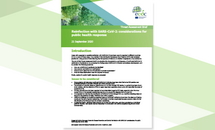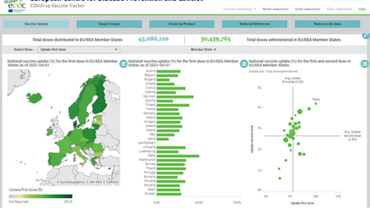Threat Assessment Brief: Implications of the emergence and spread of the SARS-CoV-2 B.1.1. 529 variant of concern (Omicron) for the EU/EEA
A SARS-CoV-2 variant belonging to Pango lineage B.1.1.529, with a high number of S-gene mutations compared to the original virus was detected at the beginning of November 2021. On 26 November 2021 the variant was designated a variant of concern (VOC) and assigned the label Omicron by the World Health Organization (WHO).
Executive Summary
The variant is characterised by 30 changes, three small deletions and one small insertion in the spike protein, of these, 15 are in the receptor binding domain. This variant was first detected in samples collected on 11 November 2021 in Botswana and on 14 November 2021 in South Africa. As of 26 November 2021, travel-related cases have also been detected in Belgium, Hong Kong and Israel. The Omicron variant is the most divergent variant that has been detected in significant numbers during the pandemic so far, which raises concerns that it may be associated with increased transmissibility, significant reduction in vaccine effectiveness and increased risk for reinfections. As of 26 November 2021, ECDC has classified this variant as a variant of concern (VOC) due to concerns regarding immune escape and potentially increased transmissibility compared to the Delta variant.
Risk assessed
What is the risk associated with the introduction and possible community spread of the SARS-CoV-2 variant Omicron in the EU/EEA?
There is considerable uncertainty related to the transmissibility, vaccine effectiveness, risk for reinfections and other properties of the Omicron variant. However, given its immune escape potential and potentially increased transmissibility advantage compared to Delta, we assess the probability of further introduction and community spread in the EU/EEA as HIGH. In a situation where the Delta variant is resurgent in the EU/EEA, the impact of the introduction and possible further spread of Omicron could be VERY HIGH. In conclusion, the overall level of risk for the EU/EEA associated with the SARS-CoV-2 variant Omicron is assessed as HIGH to VERY HIGH. Options for response Based on the mutation profile of Omicron, partial immune escape is likely. Due to the uncertainties concerning Omicron immune escape properties, a precautionary approach is important and the timely and urgently reinforced implementation of non-pharmaceutical interventions (NPIs) in the EU/EEA is strongly advised.
Genomic surveillance remains of utmost importance for early detection of the presence of this variant, to enable the following of epidemiological trends and guide containment measures. At this early stage, avoiding travel to and from the known affected areas, as well as increased testing (with sequencing of confirmed cases), and contact tracing of COVID-19 cases with an epidemiological link to the affected areas is strongly advised. Due to the ongoing active circulation of the Delta variant, EU/EEA countries are urged to give utmost priority towards vaccination of individuals initially targeted by COVID-19 vaccination programmes that remain unvaccinated or not yet fully vaccinated. Countries should consider a booster dose for those 40 years of age and over, first targeting the most vulnerable and the elderly and could then consider a booster dose for all adults 18 years and older at least six months after completion of the primary series.







